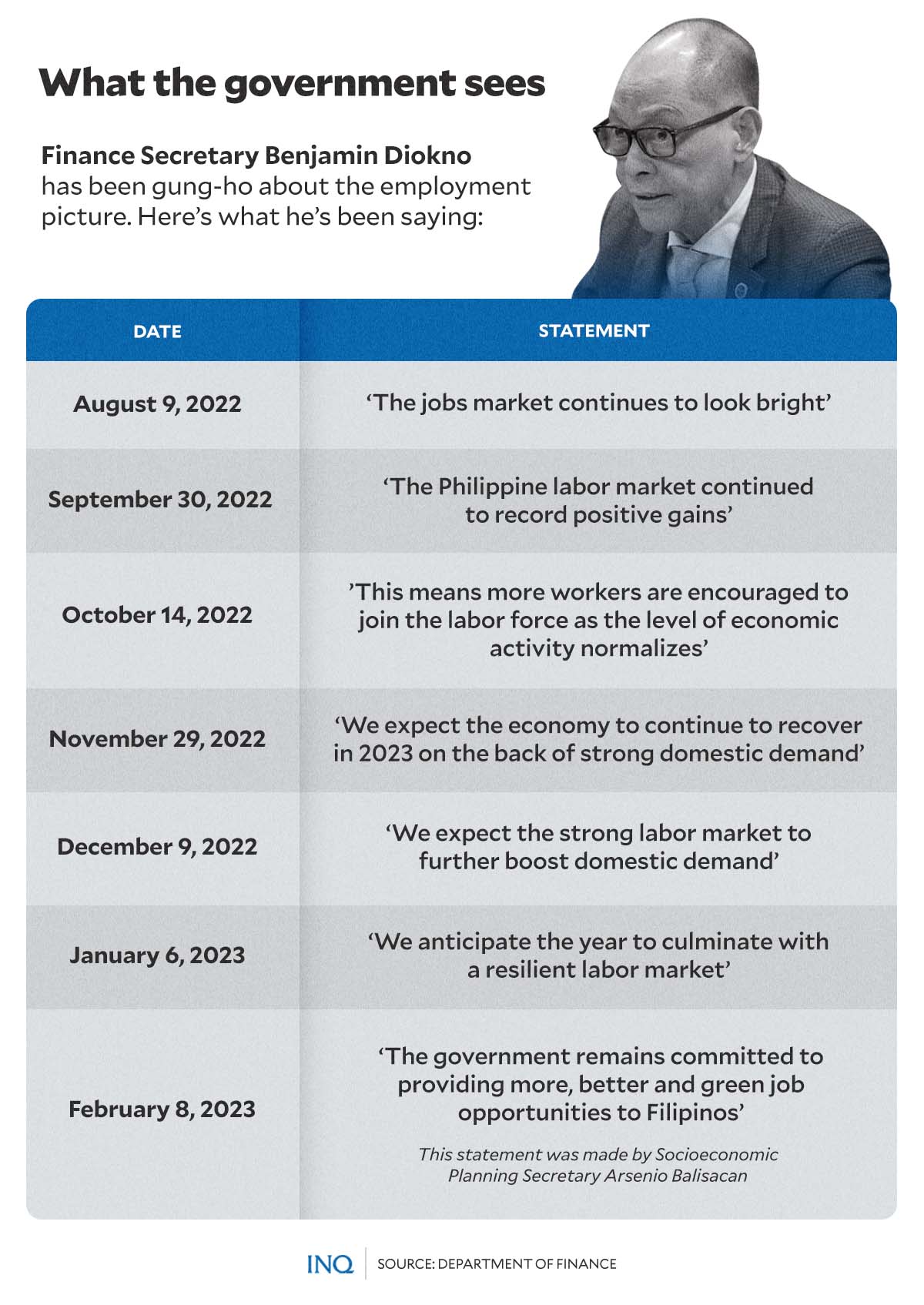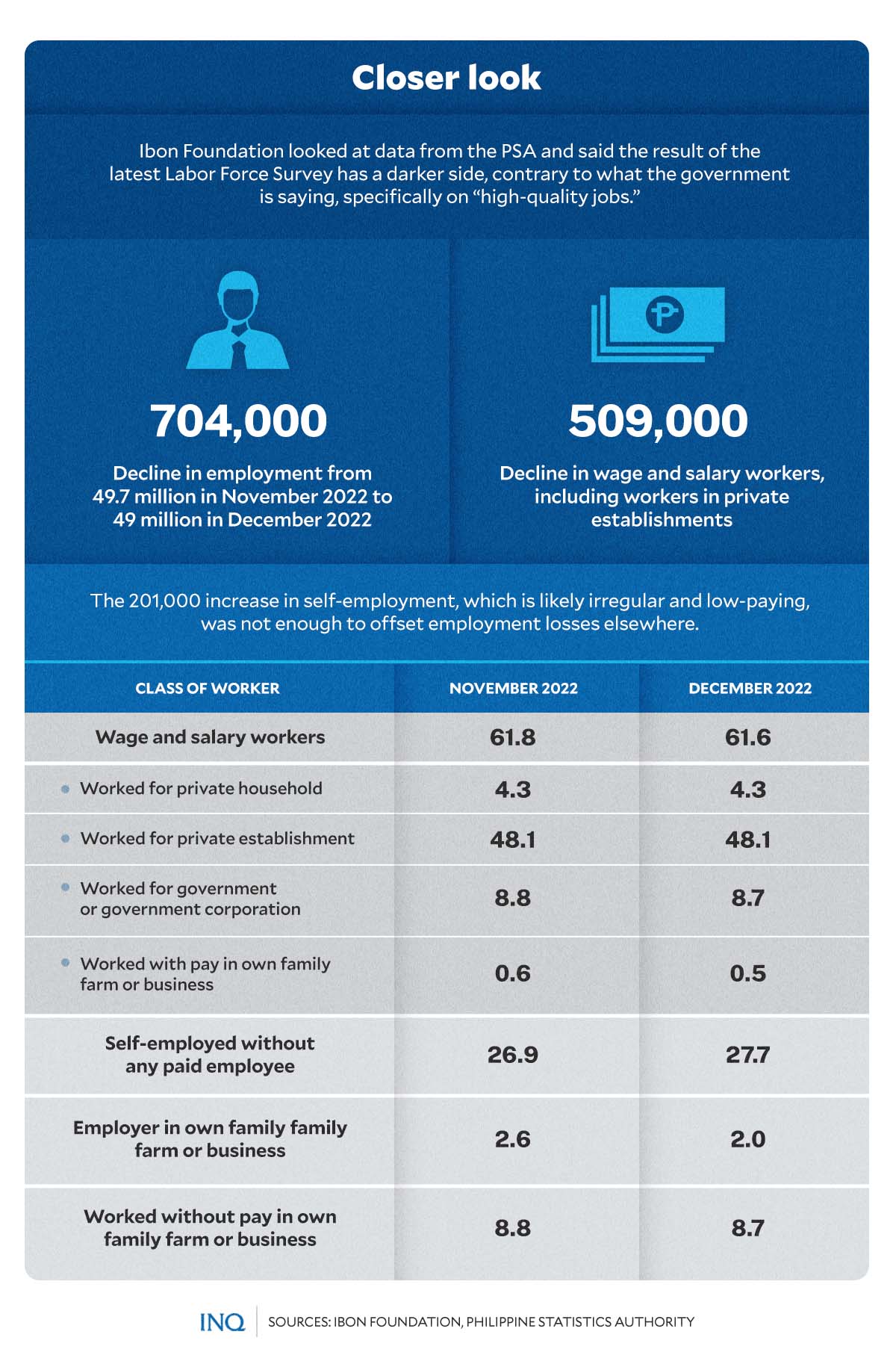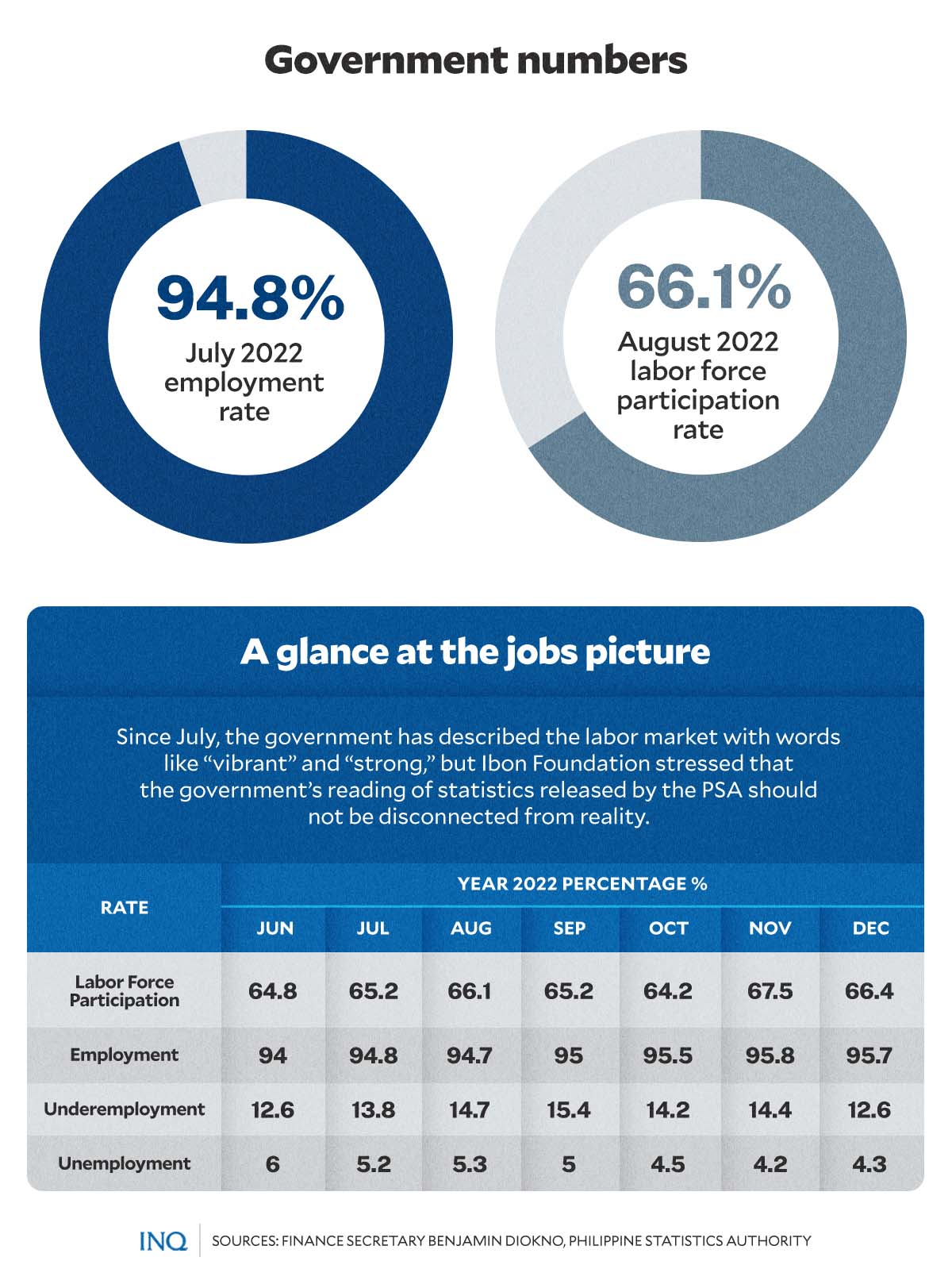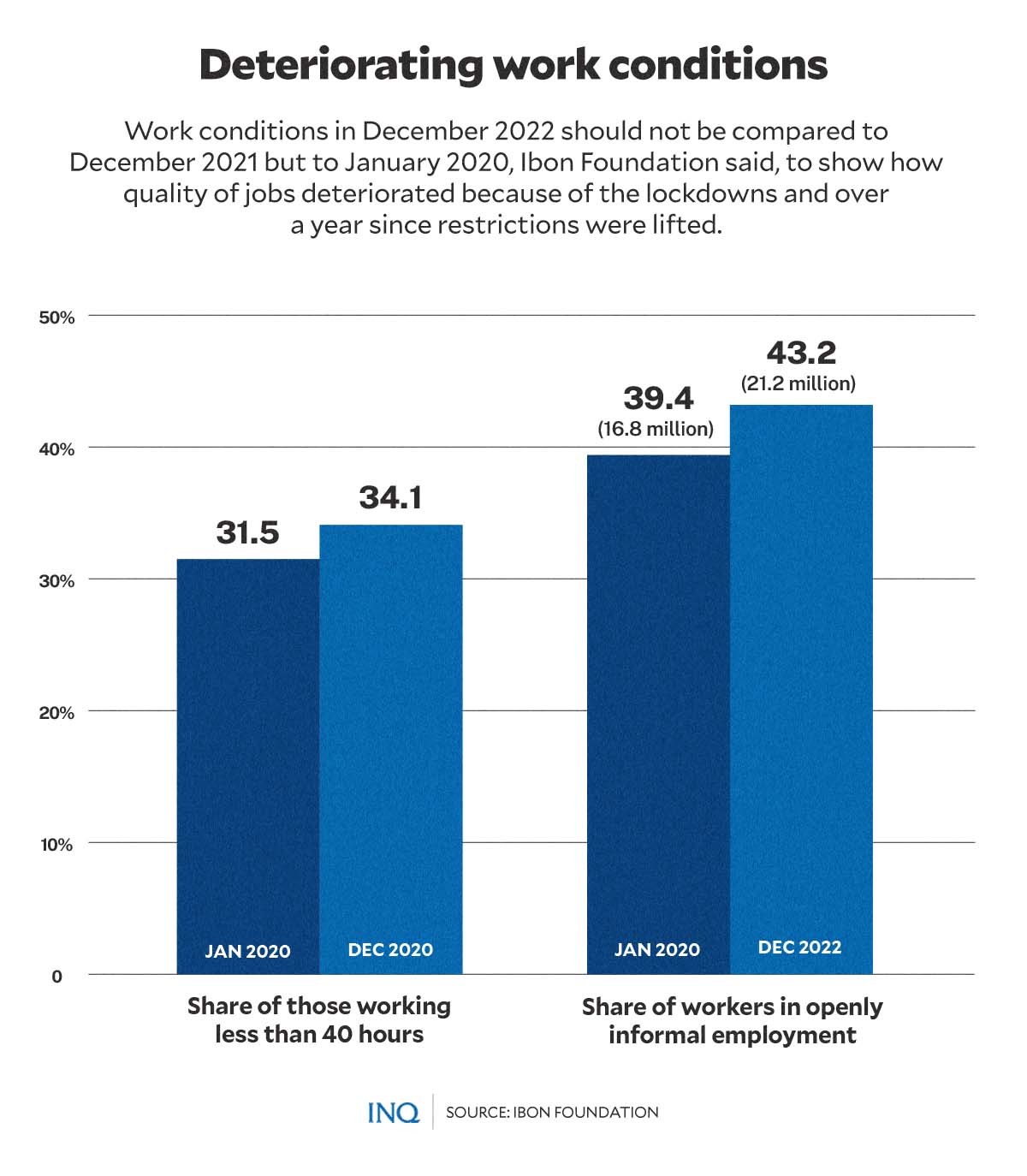‘Disconnected from reality’: Gov’t told to present more honest labor numbers

INQUIRER FILE PHOTO
MANILA, Philippines—“Vibrant” was how the National Economic Development Authority (Neda) described the labor market as the Philippine Statistics Authority (PSA) said fewer Filipinos were jobless in December 2022 compared to December 2021.
As Socioeconomic Planning Secretary Arsenio Balisacan said, “the government remains committed to providing more, better and green job opportunities to Filipinos” to sustain a “vibrant labor market” laid out in the Philippine Development Plan 2023-2028.
With the PSA saying that unemployment rate declined to 4.3 percent in December 2022 from 6.6 percent in December 2021, translating to 1.1 million fewer jobless Filipinos, Neda said the labor market “continues to record positive gains.”
But while it’s easy to brag, the think tank Ibon Foundation stressed that the government’s reading of statistics released by the PSA should not be disconnected from reality, especially of Filipinos still reeling from the effects of the COVID-19 lockdowns.
“To be clear, this is not to say that the economic managers are lying in the way that Mark Twain said that there are three kinds of lies: ‘Lies, damned lies, and statistics’,” Ibon said, highlighting the “different story” that the PSA data present.
Article continues after this advertisementIbon Foundation said on Feb. 11 that “it is to say that they are using the persuasive power of statistics to tell something that is less truthful than what a more honest reading of the statistics truly shows.”
Article continues after this advertisementGov’t picture
The think tank’s executive director, Sonny Africa, who is an economist himself, listed the words—seven to be exact—that the government used to describe the labor market since June 2022, the last month of the Duterte administration.
Looking back, when both the employment and unemployment rates did not move in June 2022 and stayed the same as the 94 percent and 96 percent in May 2022, Finance Secretary Benjamin Dioko said the jobs market continued to “look bright.”

GRAPHIC Ed Lustan
As the employment rate increased to 94.8 percent and jobless rate decreased to 5.2 percent in July 2022, Diokno said the labor market continued to record positive gains. According to data from the PSA, though, underemployment increased to 13.8 percent from 12.6 percent.
Back in August, Diokno, also former governor of the Bangko Sentral ng Pilipinas (BSP), said “we are seeing continued improvements” despite the employment rate declining to 94.7 percent and unemployment and underemployment rates rising to 5.3 percent and 14.7 percent.
Then in September, with the employment rate increasing to 95 percent and jobless rate decreasing to 5 percent, Diokno said there is a “steady improvement in labor market conditions” even if underemployment increased to 15.4 percent from 14.7 percent.
Diokno, in January 2023, referred to the labor market as “strong,” especially given the employment rate rising to 95.5 percent and unemployment and underemployment rates declining to 4.5 percent and 14.2 percent.

GRAPHIC Ed Lustan
Then with employment rate slightly increasing to 95.8 percent and unemployment rate falling to 4.2 percent, the finance secretary said “we anticipate the year to culminate with a resilient market.”
As Ibon Foundation said, the government spreading “a kind of ‘coherent’ story” but clearly “disconnected from reality” hinders the search for real solutions, especially to what it described as a “discouraging” labor market.
PSA data
As the PSA said, the unemployment rate in December 2022 was at 4.3 percent or 2.22 million, the second lowest since April 2005. It was slightly higher than the previous month’s 4.2 percent or 2.18 million, though.
READ: Jobless rate inched up to 4.3% in December 2022
When it comes to employment rate, 49 million or 95.7 percent were employed in the last month of 2022, slightly lower than the 49.7 million or 95.8 percent in November 2022, the PSA said on Feb. 8.
The PSA said underemployment rate also saw a decline from 14.4 percent or 7.16 million to 12.6 percent or 6.20 million, indicating that there were fewer Filipinos who expressed the desire to have more hours of work.

GRAPHIC Ed Lustan
The top employment contributors in the last month of 2022 included wholesale and retail trade, service activities, and accommodation and food service activities, which were “boosted by the full resumption of commercial activities, pent-up demand, and holiday spending.”
However, as Balisacan stressed, the Neda admitted that “these were tempered by losses in agriculture due to weather disturbances and the spread of infectious diseases among livestock and poultry.”

GRAPHIC Ed Lustan
Despite the headwinds, though, the socioeconomic planning secretary said “we are steadfast in pursuing this year’s growth target amidst global and domestic risks to ensure that jobs are preserved and new employment is generated.”
“Generating more and high-quality jobs in the agriculture sector and ensuring food security for Filipinos remain part of our top priorities,” Balisacan said as he highlighted the need to increase income-earning ability of Filipinos to develop their employability in the market.
Dark side
But how did the think tank say that results of the PSA’s Labor Force Surveys have a different story to tell? It checked data to look at “high-quality jobs” that the government said Filipinos “pursue and attain” in the last month of 2022.
“The most glaring fault is how the government’s press releases very oddly do not mention how the number of employed people really fell by 704,000 from 49.7 million in November 2022 to 49 million in December 2022,” it said.
According to data from Ibon Foundation, the biggest decline was 509,000 in the number of wage and salary workers, including 336,000 fewer jobs in private establishments in December 2022.
“There was actually a 468,000 decline in employment in own family-operated farms and businesses, which includes some wage and salary workers,” it said, stressing that “the 201,000 increase in self-employment wasn’t enough to offset employment losses elsewhere.”
RELATED STORY: Closer look at PH jobs picture shows little stable employment
According to data from the PSA, wage and salary workers fell from 61.8 percent in November 2022 to 61.6 percent in December 2022, with employment in private establishments staying at 48.1 percent.
Employment in family-operated farms or businesses, meanwhile, declined from 2.6 percent to 2 percent. Self-employment also had a minimal increase—26.9 percent in November 2022 to 27.2 percent in December 2022.
As to hours worked, the think tank said the reported 753,000 increase in full-time work, or those working 40 hours and over a week, may seem positive “but probably shouldn’t be overstated.”
“The more important question is if this increase in full-time work translated into higher family incomes. There are no signs that it did, and it seems that the contrary is the case,” Africa stressed.
This, as the Social Weather Stations said, the number of households rating themselves poor or borderline poor actually increased between June 2022 and December 2022, with the number of poor rising by 700,000 to 12.9 million and the number of borderline poor staying high at 7.8 million.
As explained by Africa, this combined 20.7 million or 80 percent is consistent with Ibon’s estimates on BSP’s data that some 18.6 million or 70 percent of households did not have any savings as of the last quarter of 2022.
Filipinos giving up
The relatively low unemployment rate of 4.3 percent “also shouldn’t be taken at face value,” the think tank said, stressing that it does not count jobless Filipinos who may have dropped out of the labor force after failing to find work.
A close look at the PSA data would show that the 66.4 percent labor force participation rate in December 2022, which is equivalent to 51.22 million, is lower by 661,000 than the 67.5 percent in the previous month, which translated to 51.88 million.
When it comes to underemployment, it said “amid a discouraging labor market, the decline in reported underemployment may not reflect more Filipinos content with their work and earnings but rather Filipinos who stopped looking for better work that is nowhere to be found.”
“While decreasing slightly in the last month of 2022, the number of Filipinos in openly informal work is still very high at 21.2 million or 43.2 percent of total employment,” Ibon Foundation said.
RELATED STORY: High underemployment smudges gov’t jobs picture
This covers the self-employed (27.7 percent), those in family-operated farms or businesses (11.2 percent), and those who worked for private households (4.3 percent).
“This does not even count initial estimates of perhaps 5.5 million more employed in informal or unregistered establishments. Taken altogether, informal work may account for some 36.1 million or 73.8 percent of total employment,” it said.
Widen gov’t view
As the Neda said, while the unemployment rate slightly increased to 4.3 percent in December 2022 from 4.2 percent in the previous month, it declined from 6.6 percent from a year ago—December 2021.
But the think tank said work conditions in December 2022 should not be compared to December 2021 but to January 2020 to show how quality of jobs deteriorated because of the lockdowns and despite over a year now since restrictions were lifted.
It said most work generated since then has been in part-time work. The share of those employed working less than 40 hours markedly increased from an already high 31.5 percent in January 2020 to 34.1 percent in December 2022 corresponding to 13.4 million and 16.7 million.
By class of worker, over that same period, those in openly informal employment rose from 39.4 percent of employed to 43.2 percent with 16.8 million and 21.2 million.
Ibon Foundation said these figures include a huge increase in the number of employed but classified as unpaid family workers, which soared from 2.7 million or 6.2 percent of those employed in January 2020 to 4.3 million or 8.7 percent in December 2022.
Then the share of those working in formal and informal private establishments fell from 51.5 percent (21.9 million) to 48.1 percent (23.5 million), with the PSA saying that employment in formal establishments actually fell from 8.9 million in 2019 before the lockdowns to less than 8.6 million in 2021.
“This indicates that the increase in employment in private establishments in the LFS is mostly in informal establishments,” it said.
Filipinos in low-paying jobs
As the think tank stressed, “we can also draw meaning from where the jobs created since January 2020 are.”
There are reportedly 6.5 million more employed as of December 2022, it said, but 4.5 million or nearly 70 percent of this is in agriculture (2.1 million) and wholesale and retail trade (2.3 million).
“These are literally the two lowest-paying and -earning sectors in the economy, with among the worst informality. Ibon Foundation for instance estimates that 98 percent of agriculture and 76 percent of trade is informal work,” it said.
“Those two sectors are traditional catch basins of the economically displaced and the last resort of those unable to find work anywhere.”
Filipinos desperate for work have crowded into them so much since the lockdowns that sectoral labor productivity in both, measured as value-added in gross domestic product divided by employment, is around 10 percent less in 2022 than in 2019.
“[This] is an indirect indicator of how much average incomes in them have fallen even further.”
Ibon Foundation said the lack of sufficient jobs and the poor quality of jobs are not mere labor issues to be fixed with individualized approaches of worker training, skills development and improving employability in the labor market.
“Without bolder measures like comprehensive national industrial and technology policy to build Filipino manufacturing, for instance, the economy will never be able to create enough formal, productive and high-paying jobs for its growing work force and population,” Ibon said.
“A better story for the economy can be told – but this is best done with a real reimagining of policy and really building the domestic economy, and not with misleading propaganda,” it said.